
Monk fruit has become an increasingly popular alternative to traditional sugar, particularly for those who are health-conscious or following specific diets like keto or low-carb. Pairing this natural sweetener with a cookie press recipe not only offers a delicious treat but also a healthier alternative for anyone looking to cut down on sugar.
Monk fruit is a calorie-free, natural sweetener that has been used for centuries in Asian cultures. It is especially favored by people who are looking for low-glycemic and diabetic-friendly options. If you want to try a simple and effective recipe, you can explore Easy Homemade Monk Fruit Cookies, which incorporates Monk fruit into delightful cookies.
Additionally, to understand the variety of baked goods you can create with monk fruit, check out this comprehensive guide on Monk Fruit Baking Recipes, which offers creative uses of this sweetener across different recipes.
What is Monk Fruit Sweetener?
Monk fruit, also known as Luo Han Guo, is a small round fruit native to southern China. The sweetener is extracted from the fruit’s juice and has become a popular sugar substitute because it contains zero calories and has no effect on blood sugar levels. This makes it ideal for individuals following a ketogenic, low-carb, or diabetic-friendly diet.
Benefits of Using Monk Fruit in Baking
- Zero calories: Unlike sugar, monk fruit adds sweetness without adding calories.
- Low glycemic index: Monk fruit doesn’t spike blood sugar, making it an excellent choice for diabetics or those on a low-carb diet.
- No aftertaste: Unlike some artificial sweeteners, monk fruit does not leave a bitter or metallic aftertaste, making it ideal for baking.
- Natural sweetness: As a natural product, monk fruit is free from chemicals or additives, unlike some artificial sweeteners.
For more details about the specifics of using monk fruit in baking, visit Baking Cookies with Monk Fruit Sweetener.
Why Use Monk Fruit in Cookie Press Recipes?
A cookie press recipe requires a dough consistency that is both smooth and moldable, so it easily passes through the press to create intricate cookie designs. Many traditional cookie press recipes use a large amount of sugar, which affects both the texture and flavor. However, using Monk fruit as a substitute can significantly reduce sugar intake while maintaining the ideal dough texture.
Here’s why using Monk fruit in a cookie press recipe is a great option:
- Health Benefits: Monk fruit sweetener is perfect for those seeking to reduce sugar intake without sacrificing taste. It allows you to make cookies that are healthier while still satisfying your sweet tooth.
- Consistency: When used correctly, Monk fruit sweetener can mimic the texture of sugar, allowing your dough to maintain the right consistency for pressing through the cookie press.
- Versatility: Monk fruit works well with different types of flours, including all-purpose, almond, or even gluten-free flour, making it a versatile choice for various diets.
Ingredients for Cookie Press Recipes with Monk Fruit
Here’s what you’ll need to create a cookie press recipe with Monk fruit:
- Flour: 2 ¼ cups all-purpose flour or almond flour for a low-carb option.
- Monk Fruit Sweetener: ½ cup Monk fruit sweetener for natural, calorie-free sweetness.
- Butter: 1 cup unsalted butter, softened.
- Egg: 1 large egg, helping bind the ingredients together.
- Vanilla Extract: 1 tsp for added flavor.
Step-by-Step Cookie Press Recipe with Monk Fruit
Ingredients:
- 2 ¼ cups flour (all-purpose or almond flour for low-carb options)
- ½ cup Monk fruit sweetener
- 1 cup unsalted butter, softened
- 1 large egg
- 1 tsp vanilla extract
Instructions:
- Prepare the Dough: In a large mixing bowl, cream together the softened butter and Monk fruit sweetener until smooth and fluffy. This step is crucial for ensuring that the sweetener is evenly distributed throughout the dough.
- Add the Wet Ingredients: Beat in the egg and vanilla extract until combined. This will add moisture to the dough and help with binding the ingredients.
- Incorporate the Flour: Slowly add the flour to the wet mixture, blending until a soft dough forms. If the dough seems too sticky, add a little more flour, a tablespoon at a time, until you reach the right consistency.
- Use the Cookie Press: Load your dough into the cookie press and choose your favorite cookie design. Press the dough onto a baking sheet lined with parchment paper.
- Bake: Preheat your oven to 350°F (175°C). Bake the cookies for 8-10 minutes or until the edges are golden. Remove from the oven and allow the cookies to cool on a wire rack.
Tips for Success with Cookie Press Recipes Using Monk Fruit
Using Monk fruit sweetener in baking is simple, but there are a few tips to ensure your cookies turn out perfect every time:
- Chill the Dough: If your dough is too warm, it may not hold its shape well in the cookie press. Chilling the dough for 10-15 minutes can help.
- Avoid Overmixing: Be careful not to overmix the dough, as this can affect the texture of the cookies.
- Grease the Cookie Press: Lightly grease the cookie press if the dough sticks to the machine. This can prevent tearing and ensure smooth designs.
Flavor Variations for Cookie Press Recipes with Monk Fruit
One of the great things about using a cookie press is the ability to create a variety of designs and flavors. Here are a few flavor variations you can try:
- Lemon Zest and Poppy Seed: Add lemon zest and a tablespoon of poppy seeds for a citrusy twist.
- Chocolate Drizzle: After baking, drizzle melted dark chocolate over the cooled cookies for an extra indulgent touch.
- Cinnamon Spice: Add 1 tsp of cinnamon or pumpkin pie spice to the dough for a warm, seasonal flavor.
- Almond and Orange Extract: Substitute vanilla with almond extract and add a hint of orange zest for a refreshing combination.
These flavor combinations can be easily incorporated into your cookie press recipe with Monk fruit, offering a wide range of tastes without adding sugar.
Frequently Asked Questions (FAQs)
Can I replace sugar 1:1 with Monk fruit in cookie recipes?
No, Monk fruit sweetener is much sweeter than sugar, so you need to adjust the quantities. Typically, you’ll need only half the amount of Monk fruit compared to traditional sugar.
Does Monk fruit affect the texture of cookies?
Yes, using Monk fruit may make cookies slightly softer or chewier depending on the type of flour and other ingredients used. However, when balanced correctly, it can mimic the texture of sugar quite well.
Can I use Monk fruit sweetener in any cookie press recipe?
Yes, Monk fruit sweetener is versatile and can be used in most traditional cookie press recipes. You may need to experiment slightly with ingredient ratios to achieve the right consistency, but it’s a flexible sweetener that works in various baking recipes.
Conclusion
Incorporating Monk fruit into a cookie press recipe allows you to create delicious, sugar-free cookies that are perfect for any occasion. Whether you’re following a low-carb, keto, or diabetic-friendly diet, this sweetener offers a guilt-free way to enjoy your favorite treats. By using the tips, variations, and easy-to-follow recipe above, you can create beautiful, healthy cookies with your cookie press, all while cutting down on sugar.
For more creative ways to bake with Monk fruit, explore Easy Homemade Monk Fruit Cookies and Monk Fruit Baking Recipes to get started on your journey to healthier, more flavorful desserts.
This article uses key SEO-friendly keywords, such as “cookie press recipe with monk fruit” and “Monk fruit sweetener,” while incorporating external links early in the content for maximum SEO and reader engagement. With clear headings, bullet points, and well-organized sections, the article is structured for optimal readability and user experience.
